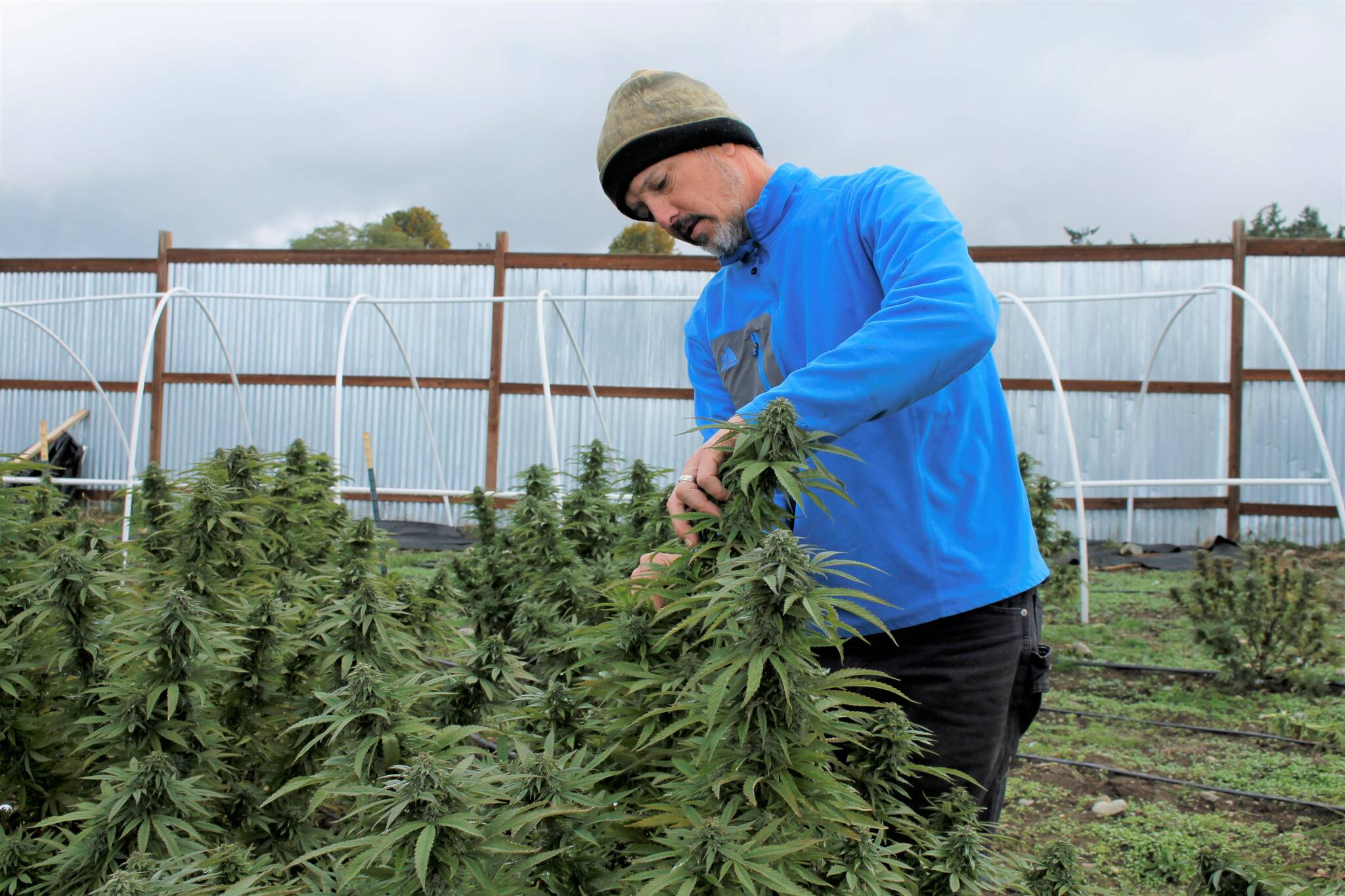With the start of autumn, leaves are falling, pumpkins are maturing on the vine and over in Langley, the cannabis branches are ripe for the bucking.
On a chilly October morning, volunteers approach bushes of kush with shears in hand at the South Whidbey farm owned by Adam Lind. It’s harvesting time for the 18 different strains of marijuana plants grown on about two-thirds of an acre at the production and processing facility known as THC Services.
Using a jeweler’s loupe, Lind checks the color of the trichomes — tiny, hair-like structures located on the flowers of the plant — for ripeness. When they turn amber, it’s go time.
“It’s like an apple,” Lind said. “Once that apple’s perfectly ripe, you want to pick it. You can still pick it when it’s overly ripe and it’s okay but it’s not as good. Same thing with cannabis. If it gets too ripe, it’s still good but not quite as good. You’ve got to get it at its peak.”
Lind’s farm in the Bayview area has been in operation for the past few years. Site plans, which included the use of a tall metal corrugated fence and several surveillance cameras, were approved in 2016 by the county’s hearing examiner amidst concerns from neighbors opposing the project.
This year’s harvest is expected to yield between 800 to 1,000 pounds of material. That’s 362,874 to 453,592 grams for the marijuana-savvy.
Once branches are cut, they are hung upside-down to dry for seven to 10 days in a shipping container on the property. After drying, the buds are separated from the branches — a process known as bucking — and weighed following two to three weeks of curing.
From there, the ganja undergoes a rigorous testing process. A sample from each five-pound batch of product must be sent for testing to a state-certified laboratory.
“The flower can hold a lot of contamination and if it doesn’t pass that testing, I can’t sell it legally at retail,” Lind said.
Contamination could be mold, mildew or even bug poop.
If the sample doesn’t pass testing for combustible use, that does not mean the entire batch should be thrown away. Rather, Lind explained that it can be used to create kief, the collection of trichomes sifted from the flowers. Rosin, an extract, can be made by adding heat and pressure to kief.
Lind touts his farm as being both organic and environmentally conscious. He employs no chemicals for pest control and uses about 5,000 or 6,000 gallons of water per year. For comparison, marijuana growers are allowed to use 5,000 gallons per day.
“I’m very low-carbon footprint,” Lind said. “I use less water and less electricity than an average household does on an annual basis. Most anybody else in our industry is not anywhere close to that. They’re using a large portion of the energy grid.”
He cited that the cannabis industry uses up about 2 to 3% of the energy grid.
“Which doesn’t sound like a huge number, but if you’re just looking at one small industry, that’s taking up that amount and it’s a pretty good chunk,” he said.
Lind believes he is the only producer in Island County who grows all of his plants outdoors. The industry, especially in Western Washington, tends to favor growing indoors with heat lamps.
“We don’t have a really long outdoor growing season here in Washington state and so you have to be on top of it,” he said. “If you lose any momentum with your plants, you’re kind of screwed. You have to be a pretty passionate cannabis gardener to be able to do this.”
Recently, he has been experimenting with light deprivation, a growing technique that doubles his harvest if done correctly.
He can plant as early as May or June. If left undisturbed, the plants will start to flower in August, as daylight gets lesser. Lind expedites this process by putting a tarp over the crops in June or July around 5 p.m. A few hours later, he removes the tarp when it’s actually dark, and the plants awaken to natural daylight. Controlling the amount of daylight allows him to harvest plants earlier and repeat the process so he has a second harvest by October.
In years past, Lind has sold his products wholesale. This year, he will be trying his hand at selling to retailers, some of which are cannabis shops on Whidbey.
The farm’s brand will be called Kenny’s Gold Select in memory of Lind’s business partner and close friend, Kenny Kramer, who passed away about five months ago. A portion of sales will go towards a high school scholarship foundation for South Whidbey students named after Kramer.
Plants grown on the farm are mostly hybrids, meaning they are a mix of indica and sativa varieties. They have quirky names such as “AK-47” and “Amsterdam Ice Cream.”
Volunteers help with the harvesting process every year.
The best thing about volunteering?
The pungent smells.
“You go home and you smell really good. It lasts for a while,” volunteer Deb Gould said with a laugh. This is her second year being part of the harvest.
Micah Petrich, another volunteer, was drawn to the farm. He decided to check it out one day.
“Adam was such a nice dude. He welcomed me in, showed me around and offered me a job,” Petrich said.
After snipping branches, both volunteers begin the drying process by hanging them upside down in a net mechanism set up in one of the farm’s storage containers.
“I believe wholly in the plant as medicine,” Lind said. “I think that it’s really, really beneficial. I really feel like it’s here to stay and more and more research needs to be done on cannabis so we can find out its benefits, and some of the negative effects of it as well.”
An earlier version of this story contained inaccurate information that said volunteers receive cannabis for free. It has been updated with the correct information.



